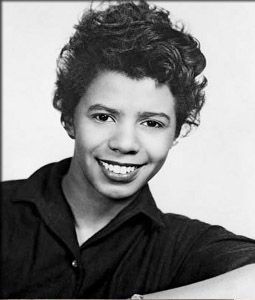Address: 6556 35th Ave NE Seattle, WA 98115
Service: Sundays at 9:30am and 11:15am in-person or online
Phone: 206-525-8400
From UUC's Acting for Racial Justice Team
March is Women’s History Month and the 2024 theme celebrates “Women Who Advocate for Equity, Diversity and Inclusion.” This theme recognizes women who understand the need to eliminate bias and discrimination from individuals' lives and institutions.” (1) One of the incredible women who has done just this, was American playwright and writer, Lorraine Vivian Hansberry. Hansberry was a Black, queer woman who used her art to express her radical vision for America and the world.
In May 1963, a group of prominent Black people met with U.S. Attorney General, Bobby Kennedy. Hansberry, who was thirty-three at the time, wholly surprised the attorney general. James Baldwin, who was also in the meeting, wrote: “We wanted him to tell his brother the President to personally escort to school . . . a small black girl already scheduled to enter a Deep South school. ‘That way,’ we said, ‘it will be clear that whoever spits on that child will be spitting on the nation.’ Kennedy did not understand and responded that this would be a meaningless moral gesture. Lorraine responded, ‘We would like from you, a moral commitment.’ He looked insulted—seemed to feel that he had been wasting his time . . . She looked at Bobby Kennedy . . . ‘But I am very worried’ she said, ‘about the state of the civilization which produced that photograph of the white cop standing on that Negro woman’s neck in Birmingham.’ She smiled a cutting smile at the attorney general, turned, and walked out.”
Lorraine Hansberry “was not raised to be a radical. She was born in Chicago in 1930, the child of an illustrious family that was well regarded in business and academic circles. Lorraine’s father, Carl Augustus Hansberry, was a real-estate speculator and a proud race man.” (2) Her parents started the first Black bank and hospital in Chicago. And “Many prominent African American social and political leaders visited the Hansberry household during Lorraine’s childhood including sociology professor W.E.B. DuBois, poet Langston Hughes, actor and political activist Paul Robeson, musician Duke Ellington and Olympic gold medalist Jesse Owens.” (3)
Hansberry became interested in theater while in high school. She broke with family tradition of attending a Southern Black college and instead enrolled in the University of Wisconsin and majored in writing. As she grew up, she drifted away from the politics of her parents, who remained committed Republicans. . . . While at the University of Wisconsin, she began campaigning for Henry Wallace’s Progressive Party. After the police turned up at a local protest that Hansberry attended, her parents forbade her to continue supporting the insurgent candidate. “I am quite sick about it,” she wrote to a close friend. “They are afraid Little Lorraine will call up one night from the police station and ask for her pajamas.” She kept volunteering for Wallace.” (4) After two years in Wisconsin, she left to study painting in Chicago and Mexico. In 1950, Hansberry moved to New York City to write for Paul Robeson’s progressive newspaper, Freedom.
On a picket line, Hansberry met Robert Nemiroff, a Jewish songwriter who shared Hansberry’s political views, and the two were married in 1953. Even though married to a man, “Hansberry identified as a lesbian but she was not “out” in the traditional sense, as homosexuality was illegal in New York City at the time. Hansberry and Nemiroff ended their romantic relationship after nine years, but he remained her best friend and closest confidant for the rest of her life.” (5)
Lorraine Hansberry is well known for her play, A Raisin in the Sun. It was the first play written by an African American woman to be produced on Broadway, nominated for four Tony awards, and to win a New York Drama Critic’s Circle award. “In A Raisin in the Sun,” she drew upon the lives of the working-class black people who rented from her father and who went to school with her on Chicago’s South Side. She also used members of her family as inspiration for her characters.” (6) The play drew large numbers of African Americans to the theater — recognizing them and giving them representation on the stage. One Hansberry biographer said in an interview, “In Hansberry’s case, her artistic work provided a “radical” vision because it called for the transformation of how we understand our material conditions and Black people’s place in history and society.”
Shortly before Lorraine Hansberry died from pancreatic cancer, on May 1, 1964, she addressed a group of teenage national essay winners, and extolled the power of Blackness:
“I speak with you on this occasion because you are young, gifted and black. I for one can think of no more dynamic combination a person might be…Look at the work that awaits you! Write if you will. But write about the world as it is, and as you think it ought to be…Write about our people. Tell their story.” (7)
Biographer Imani Perry said, "There's been this constant theme for the past several decades," 'Oh she died so young; what would she have produced had she lived longer?' But the reality is she produced so much." Perry sees Hansberry as an inspiration for artists and activists in today’s “fraught period of history.” As she explains, “Having a role model who was always willing to speak truth to power is really important for us.” It’s impossible to know exactly what Hansberry would make of today’s America. But if she were still alive, suggests Perry, “She’d have a lot to say. That’s for sure.” (8)
Resources:
Soyica Diggs Colbert’ book on Lorraine Hansberry, Radical Vision
Imani Perry, Looking for Lorraine: The Radiant and Radical Life of Lorraine Hansberry
The Lorraine Hansberry Literary Trust: https://www.lhlt.org/works

Posted/updated on:

